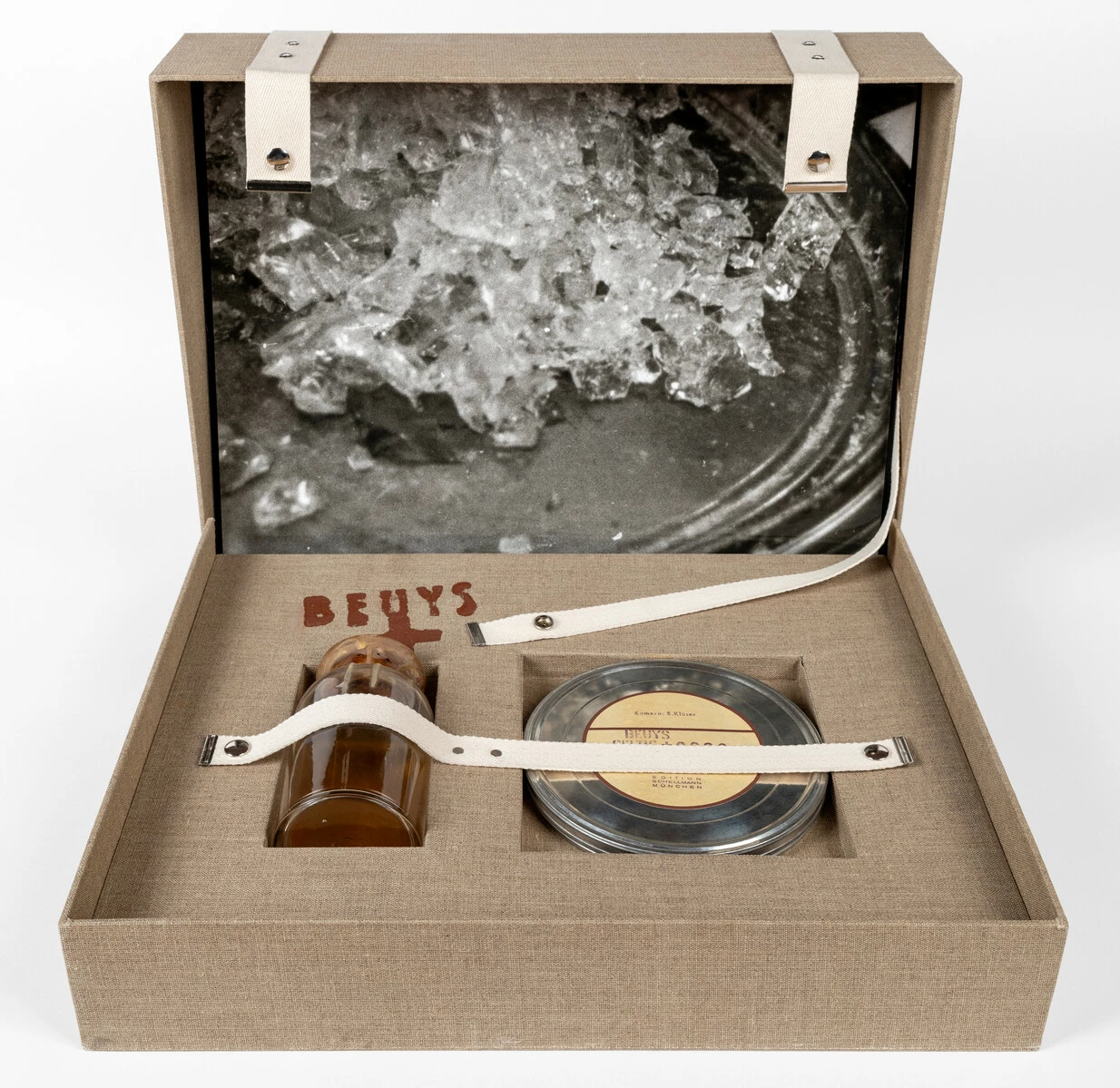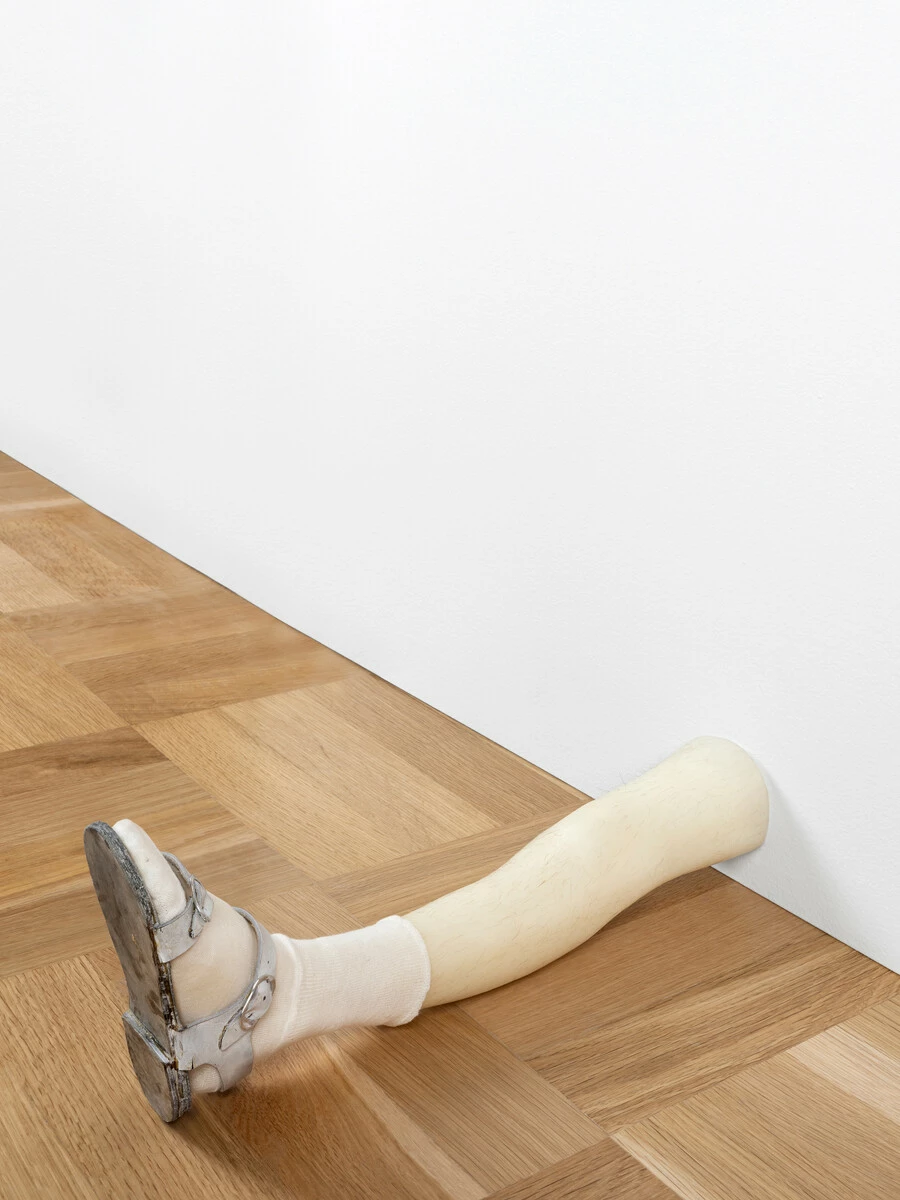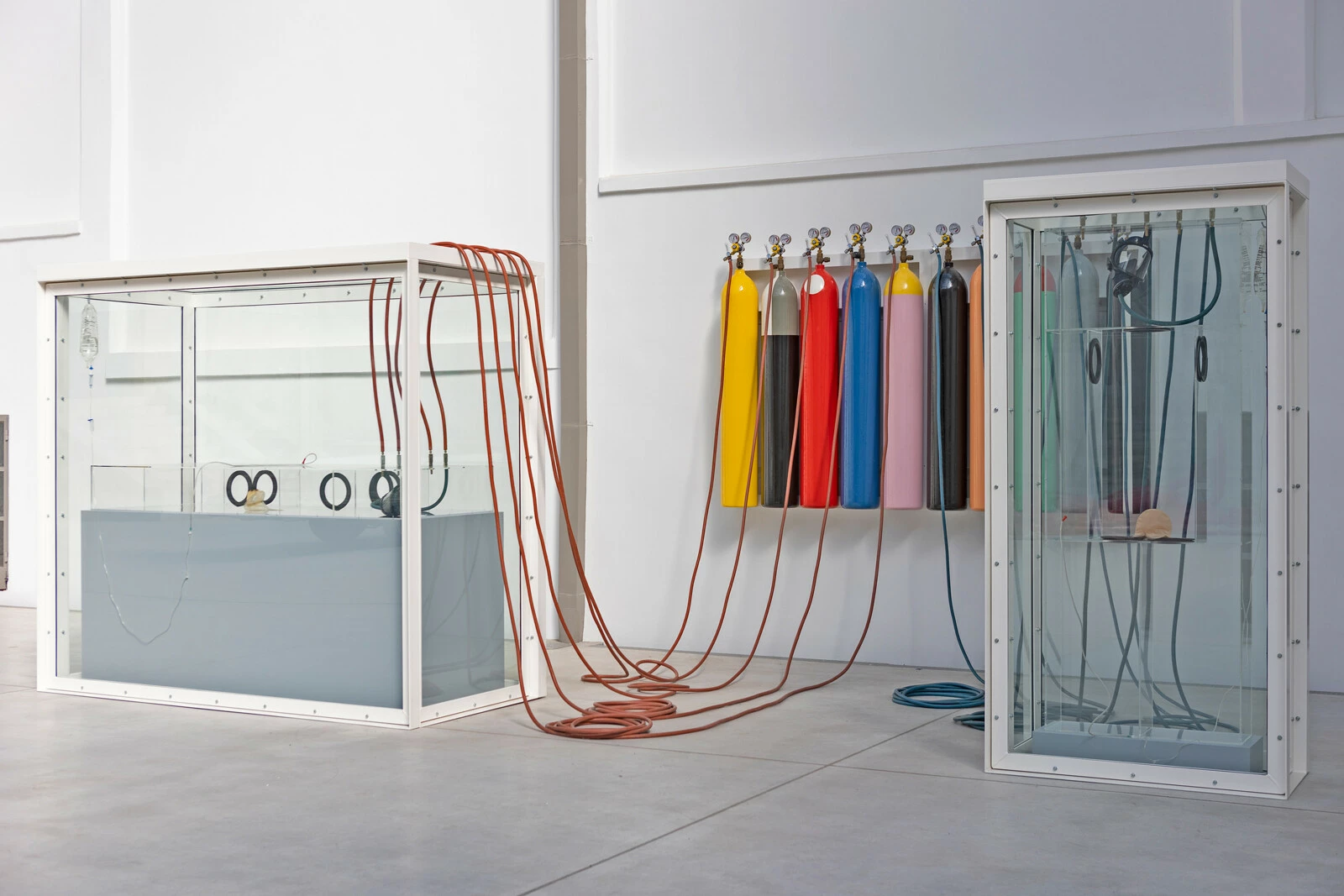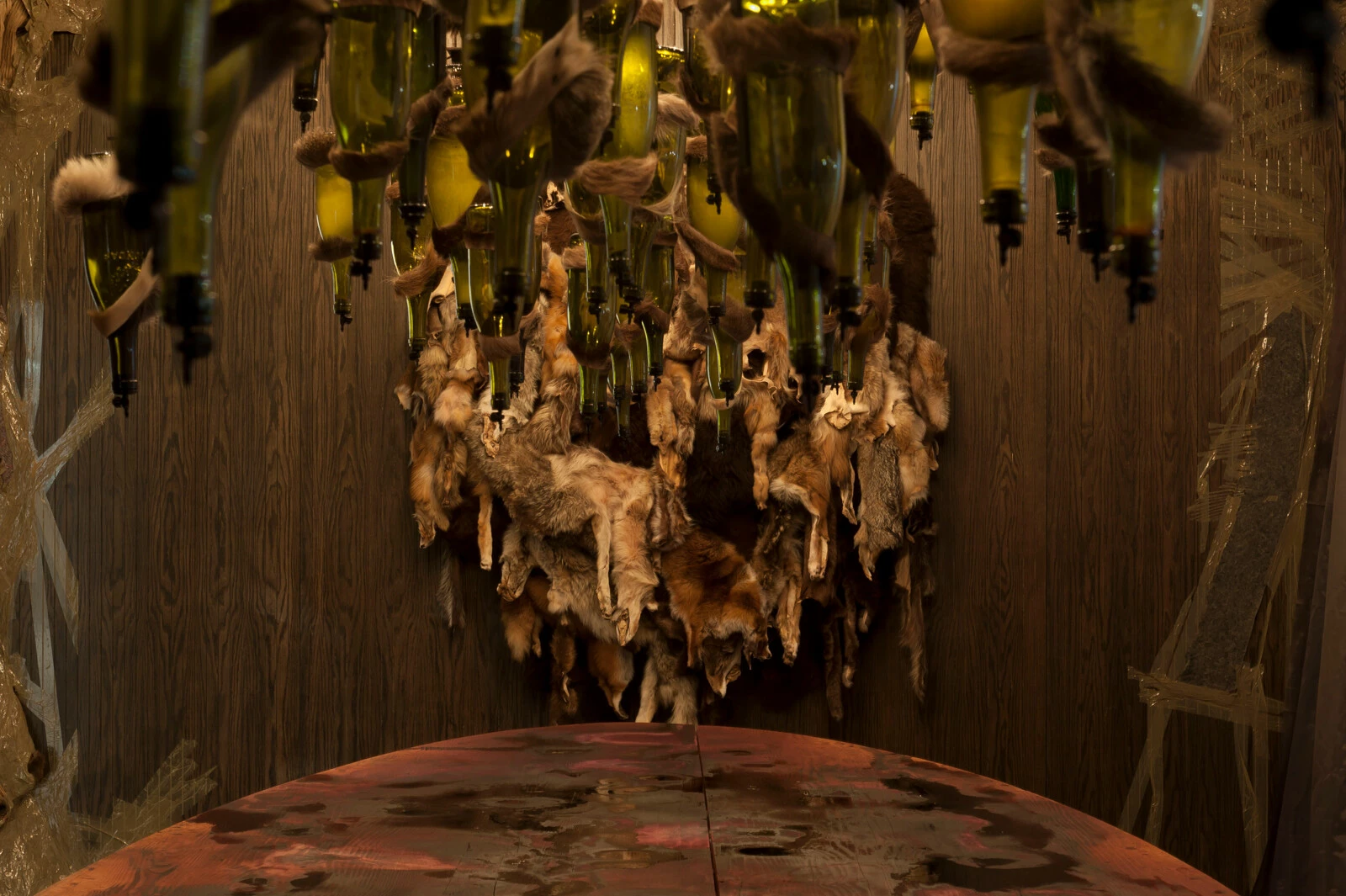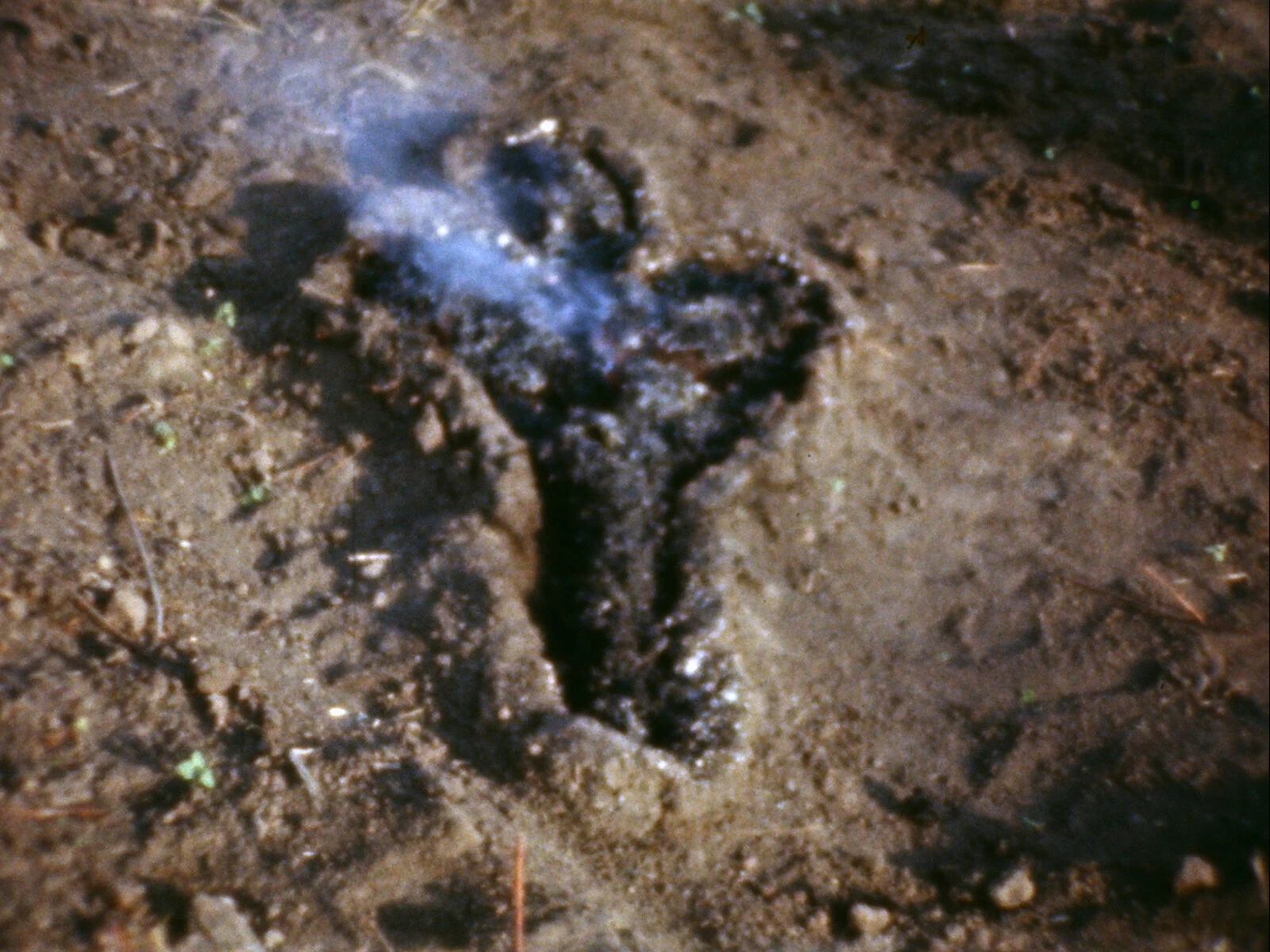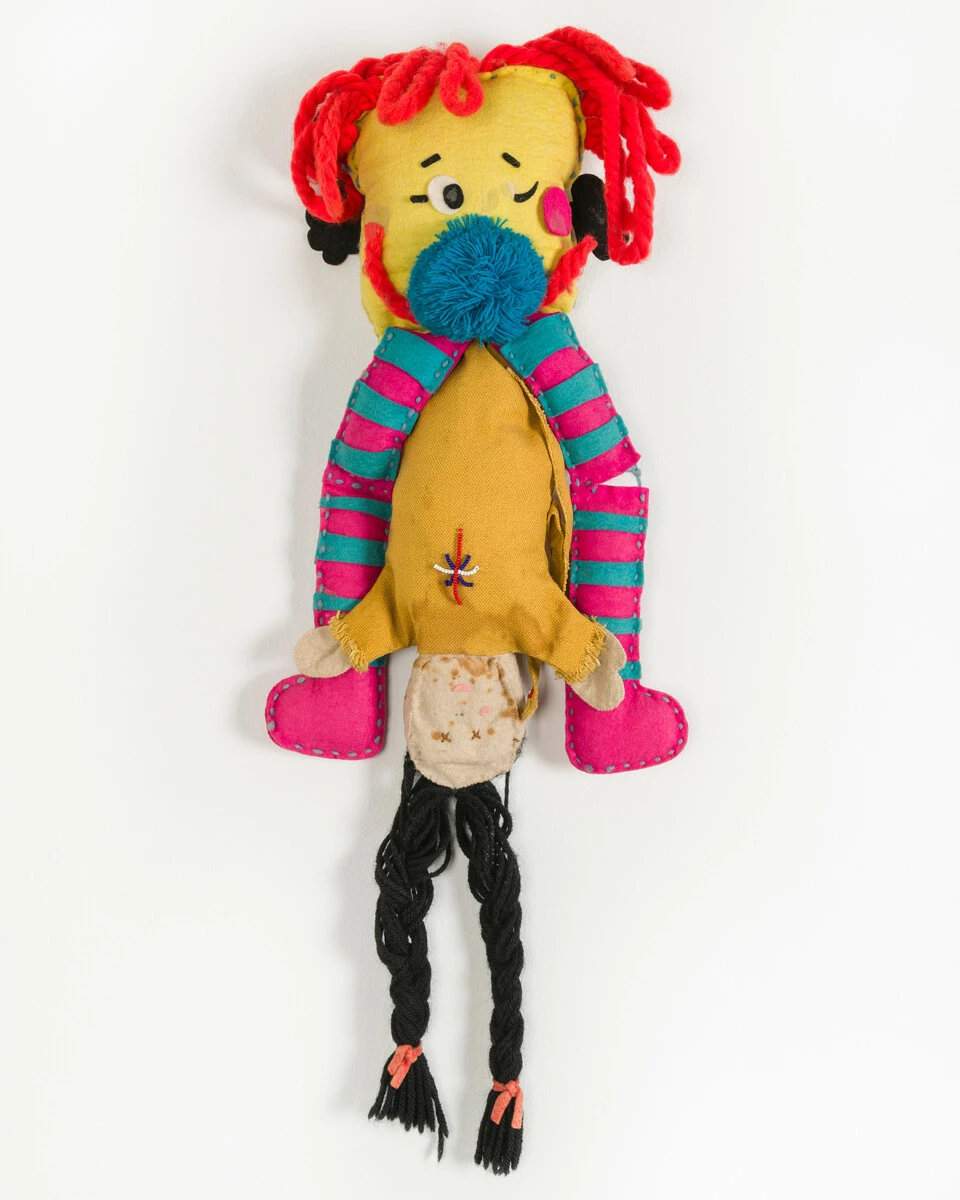The D.Daskalopoulos Collection Gift
Collection Overview
In 2022, the D.Daskalopoulos Collection gifted a remarkable body of over 100 artworks jointly to the Museum of Contemporary Art Chicago and the Solomon R. Guggenheim Museum, New York.
The collection was founded in 1994 by the Greek entrepreneur Dimitris Daskalopoulos, whose far-reaching philanthropic activities have been shaped by his unwavering belief that the experience of art can expand the collective imagination and address issues fundamental to contemporary life. It features works by some of the most influential figures of the postwar period, with a special emphasis on pieces created in the 1990s and early 2000s.
The D.Daskalopoulos Collection Gift represents a selection of key works from these extensive holdings. Encompassing 55 artists and artist groups working in a wide range of media, the gift addresses themes that are critical to Daskalopoulos’s founding collection, chief among them the tension between wonder and struggle that characterizes the human condition. This joint donation initiates an innovative collaboration between the MCA and the Guggenheim, facilitating a close exchange of curatorial ideas and technical knowledge between the two museums. The gifted works will be shown alongside the existing permanent collections of both museums, significantly expanding the narratives of contemporary art that can unfold for audiences in Chicago and New York. In addition to this transformative gift, the D.Daskalopoulos Collection donated 110 artworks to Tate, United Kingdom, and 140 artworks to The National Museum of Contemporary Art Athens (EMST), Greece.
About the Donor
Dimitris Daskalopoulos is an entrepreneur, philanthropist, art collector, and founder of NEON, a nonprofit organization committed to bringing contemporary culture closer to everyone in Greece. He is a Vice President of the Board of Trustees of the Solomon R. Guggenheim Foundation and a member of the Board of Trustees of the Museum of Contemporary Art Chicago, as well as an active member of the Tate International Council, the Leadership Council of the New Museum, and a founding partner of the Whitechapel’s Future Fund.
Daskalopoulos’s philanthropic support has enabled the creation of multiple curatorial, educational, and research-based roles that have furthered both scholarship on and public access to contemporary art. He is the recipient of honors including the Leo Award, given by the Independent Curators International (ICI) in 2014 in acknowledgement of his visionary approach to collecting and his work in establishing NEON.
“I started collecting contemporary art and very quickly found I was putting together a dialogue around a central theme, and that central theme was my marvel at human existence—this finite being, that despite its limited capacities in terms of the universe and time, [fights] on an individual level, on a level of a society, and is creating progress. For me, the body . . . is the locus of human existence [and] human existence is a struggle—thankfully, a creative one.”
—Dimitris Daskalopoulos
Featured Artworks from the D.Daskalopoulos Collection
Joseph Beuys, Celtic + ~~~~, 1971
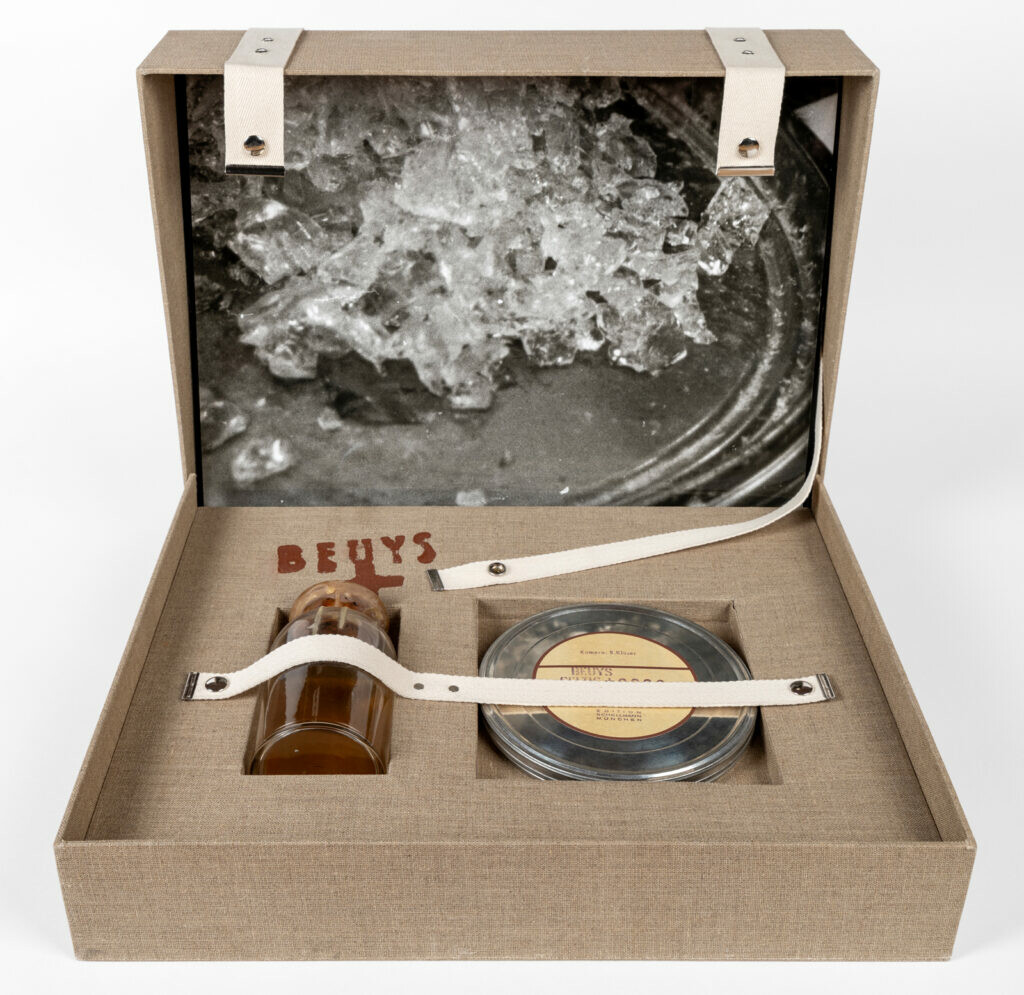
Joseph Beuys, Celtic + ~~~~, 1971. Film (super 8), ten photographs, glass bottle with gelatin and beeswax, in cloth-covered box, stamped with brown paint. Edition 6 of 100. 15 3/4 × 19 2/3 in. (each photograph); 6 1/2 × 3 in. (bottle); 7 1/2 in. (diameter, film case); 16 1/4 × 20 1/4 × 4 1/2 in. (box closed); 36 1/2 × 20 1/4 × 4 1/2 in. (box open). Gift of the D.Daskalopoulos Collection donated jointly to the Museum of Contemporary Art Chicago and the Solomon R. Guggenheim Museum, 2022.146. Photo: Shelby Ragsdale, © MCA Chicago.
Celtic + ~~~~ is one of 187 “multiples” by Joseph Beuys included in the D.Daskalopoulos Collection Gift. Between 1965 and 1986, Beuys produced over 500 multiples—editioned objects that vary in form, material, and number. While some editions included as few as six objects, others were endlessly produced. Beuys’s multiples were a significant part of his practice because they functioned as a direct-to-individual vehicle for the artist’s ideas, which were deeply informed by his social and environmental advocacy. They also allowed for his work to be distributed more widely than was possible through the traditional art market.
As with Celtic + ~~~~, Beuys’s objects were often integrally linked to his performances, or what he termed Aktionen (actions). This particular work is a suitcase containing artifacts from a 1971 performance of the same name during which Beuys spread clumps of gelatine on the walls, recollected it, and poured it over his body. The glass jar in this work holds some of that gelatinous material, while 10 photographs and a film document the action. The artwork’s title refers to the Celtic people of Scotland whose cultural heritage had a major impact on Beuys’s artistic ideas, especially his belief in sacred landscapes. The wet gelatine evokes the bogs of Scotland, which Beuys called “the last European wilderness.” An environmentalist, Beuys believed that a closer relationship with nature could heal social and political wounds.
Robert Gober, Untitled, 1992
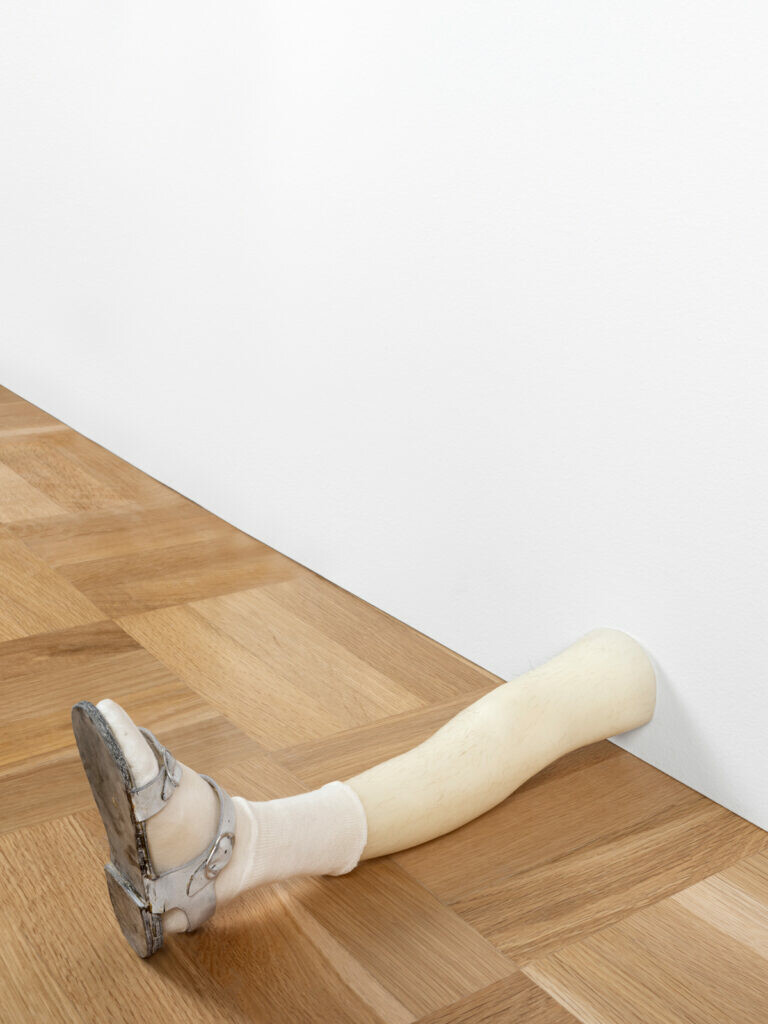
Robert Gober, Untitled, 1992. Beeswax, cotton, leather, aluminum pull tabs and human hair; 6 3/4 × 18 1/2 × 3 3/4 in. (17.1 × 47 × 9.5 cm). Gift of the D.Daskalopoulos Collection donated jointly to the Museum of Contemporary Art Chicago and the Solomon R. Guggenheim Museum, 2022.70. Photo: Shelby Ragsdale, © MCA Chicago.
Robert Gober’s hyper-realistic sculpture of a small, detached leg points to the artist’s concerns about bodily vulnerability during the darkest days of the HIV/AIDS pandemic. “I was a gay man living in the epicenter of 20th century America’s worst health epidemic,” he said, as he witnessed sickness and death in his surrounding community of New York City before the development of effective medicines. Cast in yellowish-white beeswax, with real human hairs adhered to the surface, it is unclear if the leg is presented for medical examination or for sexual flirtation. Gober’s commitment to ambiguity is a jarring reminder that existence is absurdly frail.
Damien Hirst, Greetings from the Gutter/Avoiding the Inevitable, 1994
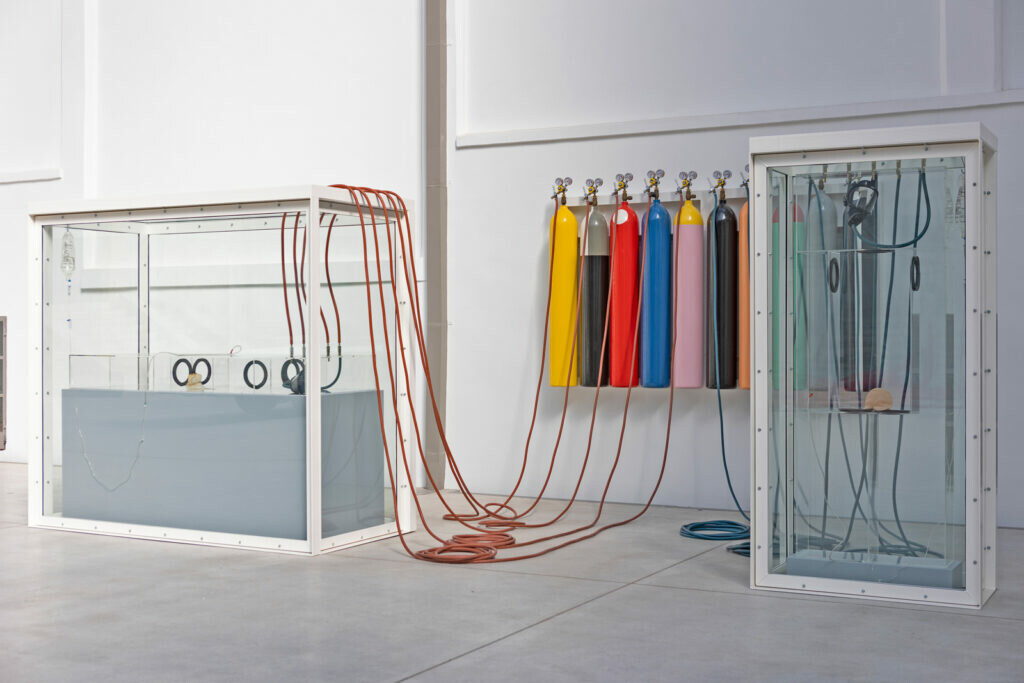
Damien Hirst, Greetings from the Gutter/Avoiding the Inevitable, 1994. Glass, steel, gas cylinders, rubber, acrylic, MDF, gas mask, saline bags and needle; dimensions variable. Gift of the D.Daskalopoulos Collection donated jointly to the Museum of Contemporary Art Chicago and the Solomon R. Guggenheim Museum, 2022.75. © Damien Hirst and Science Ltd. All rights reserved, DACS 2022. Installation view, Dream On, Hellenic Parliament + NEON, August 6–November 27, 2022. Photo © Natalia Tsoukala, courtesy NEON.
Damien Hirst’s Greetings from the Gutter/Avoiding the Inevitable is a sculpture comprising two large glass-and-steel tanks set up with gas masks, rubber tubing, infusion bags, needles, and other hospital equipment. Hirst has described the installation as an immortality machine, designed with “everything you need in order to live.” Throughout the 1990s, Hirst became internationally known for filling such glass tanks with dead animals suspended in formaldehyde as reminders of our mortality. These tanks comment on the efforts of art and science to stave off the inevitability of death.
Hirst first created Greetings from the Gutter as the cover art for pop-musician Dave Stewart’s 1995 album of the same title. Hirst reminisced that Stewart, formerly of the band the Eurythmics, told “about his drug and near-death experiences. Living in the fast lane and making a lot of money very quick, he got all that trash that goes with it and survived.” The rock and roller’s luck for cheating death is memorialized in this medically themed artwork, while the eighth track on Stewart’s album commemorates Hirst’s distinctive tanks. Titled “Damien Save Me,” the song goes: “Damien save me / And be my guide / Sooner or later / We’re all gonna die / … / Cut me in half / And I’ll let you see / What this whole wide world / Has done to me.”
Wangechi Mutu, Exhuming Gluttony: Another Requiem, 2006–11
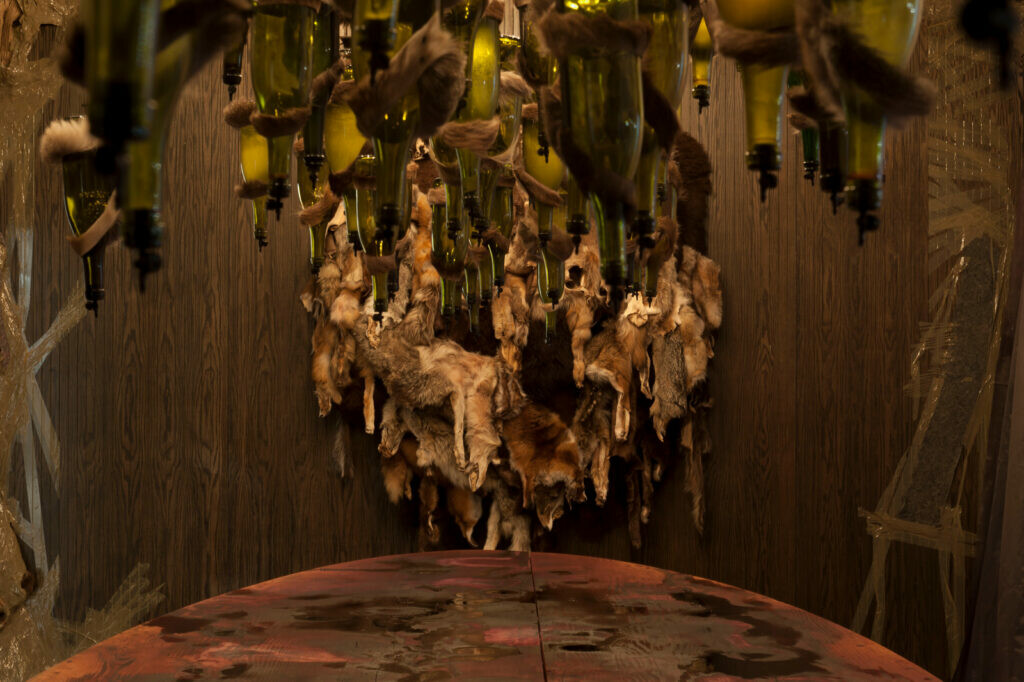
Wangechi Mutu, Exhuming Gluttony (Another Requiem), 2006–11. Mixed media installation, animal pelts, wood, bottles, wine, packing tape, linoleum, synthetic hair and blankets; dimensions variable; 140 × 434 × 177 in. (overall structure). Gift of the D.Daskalopoulos Collection donated jointly to the Museum of Contemporary Art Chicago and the Solomon R. Guggenheim Museum, 2022.89. © Wangechi Mutu. Installation view, The Luminous Interval, Guggenheim Museum Bilbao, Apr 12–Oct 16, 2011. Photo: Erika Ede.
Wangechi Mutu describes Exhuming Gluttony: Another Requiem as a “den of fables” that viewers can enter and explore. The room-sized structure features bottles of red wine that dangle upside-down from the ceiling and continuously splatter onto a large, round table. The surrounding walls are decorated with animal furs and bullet holes. The scene is meant to evoke both a sacrifice and a greedy feast gone horribly wrong. According to the artist, “The idea that we can hunt, eat, use, or consume to no end is not true. I made this artwork to warn viewers about humanity’s self-destructive tendencies.” To underscore this point, viewers exit the installation through a curtain printed with the image of a large tumor. Born in Nairobi, Kenya, Mutu’s work often serves as a critique of political power, especially the way that nations have been formed through the violent conquest of nature, animals, and people.
Ana Mendieta, Untitled: Silueta Series (Gunpowder Works), 1980
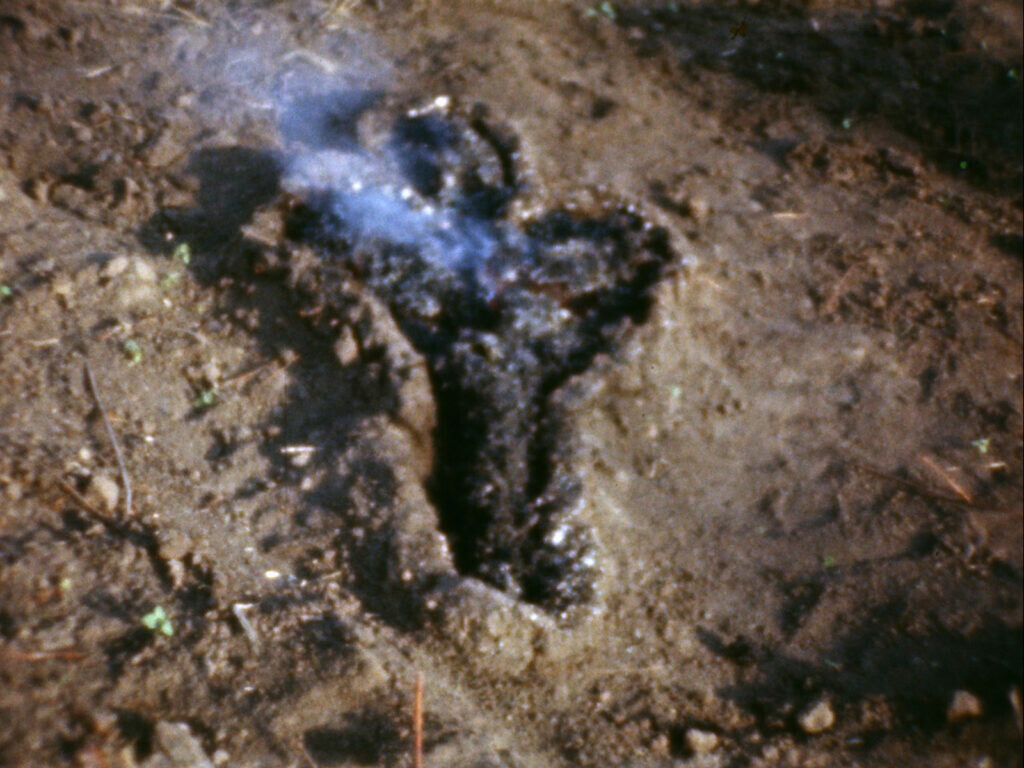
Ana Mendieta, Untitled: Silueta Series (Gunpowder Works), 1980. Super-8mm film transferred to high-definition digital media, color, silent; dimensions variable. Gift of the D.Daskalopoulos Collection donated jointly to the Museum of Contemporary Art Chicago and the Solomon R. Guggenheim Museum, 2022.88. Photo: Solomon R. Guggenheim Museum.
Ana Mendieta’s film Untitled: Silueta Series (Gunpowder Works) features the burning of an ephemeral sculpture of a woman’s silhouetted body made from soil and gunpowder. In the silent work, three vignettes spliced into one reel reveal the sequence of Mendieta’s creative destruction, from the sculpture on the tranquil forest floor, to the flash of fire, then the charred, smokey aftermath.
This artwork brings to life Mendieta’s feelings as a displaced person born in Cuba and orphaned in rural Iowa, where the film was made. Drawing inspiration from the ritual traditions of Afro-Cuban Santería, the artist used soil and fire to envision the release of her spirit to her homeland. As Mendieta wrote in an untitled 1981 poem: “In Cuba when you die / the earth that covers us / speaks. / But here, / covered by the earth whose prisoner I am / I feel death palpitating underneath / the earth.”
Mike Kelley, Untitled, 1990
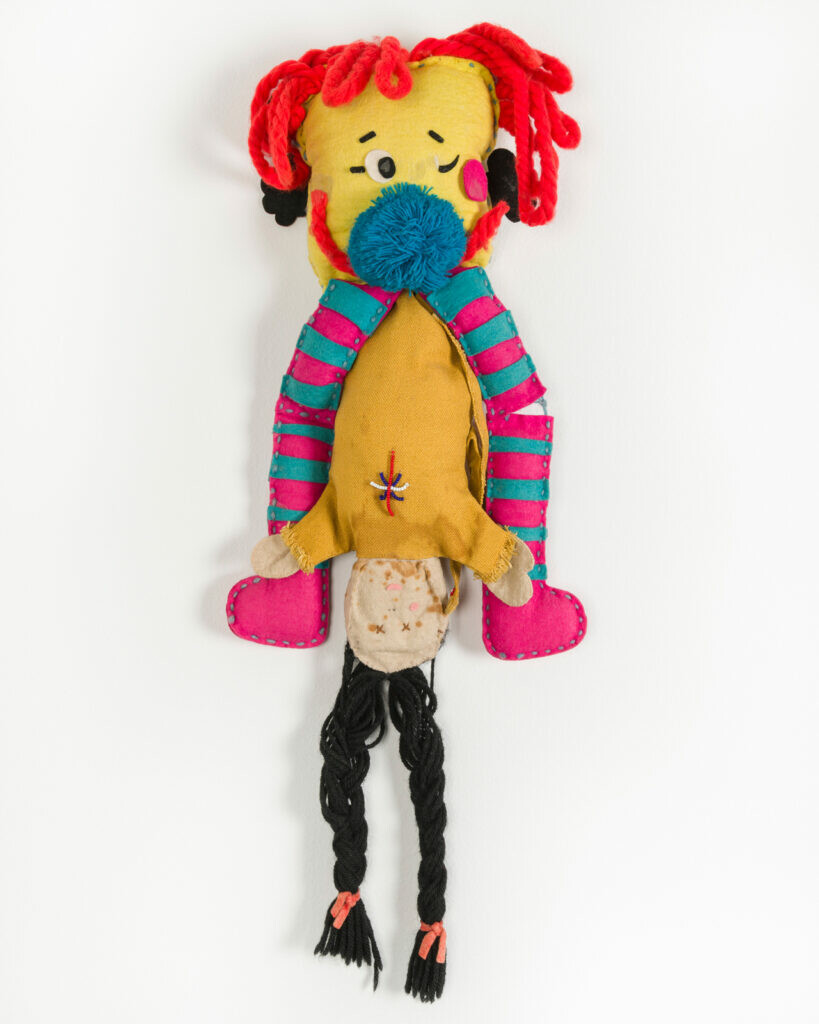
Mike Kelley, Untitled, 1990. 2 rag dolls sewn together; 30 1/4 × 3 1/8 in. (77 × 33 × 8 cm). Gift of the D.Daskalopoulos Collection donated jointly to the Museum of Contemporary Art Chicago and the Solomon R. Guggenheim Museum, 2022.79. Photo: Shelby Ragsdale, © MCA Chicago.
This signature artwork by Mike Kelley features two handmade dolls that have been reconfigured as a wall-hanging sculpture. Visibly worn and used, with stains and a missing eye, the dolls, which Kelley found at a thrift store, attracted the artist as “adult constructs”—his term for how a toymaker projects the ideas of childhood play and innocence onto a toy. By coupling the dolls in this new configuration, Kelley sought to emulate children’s natural curiosities about subjects such as sexual intimacy and birth. Kelley often placed familiar objects in strange scenarios to stoke a sensation of the uncanny.
Speaking about his own childhood experience, Kelley recalled being traumatized by “very religious, conservative and emotionally repressed” parents. “It was a tragic time for me,” Kelley said. “You can try to get beyond your childhood and I struggle to do it, but if you had a bad childhood, you’re stuck.”
View all artists included in the gift
Marina Abramović
Terry Adkins
Ghada Amer*
Kutluğ Ataman
Miroslaw Balka
Matthew Barney
Hans Bellmer
Joseph Beuys
Karla Black*
John Bock
Louise Bourgeois
Chris Burden
Paolo Pier Calzolari
Paul Chan
Savvas Christodoulides
Bruce Conner
Abraham Cruzvillegas**
Mark Dion**
Jimmie Durham
Peter Fischli and David Weiss
Tom Friedman*
Gilbert & George
Robert Gober
David Hammons
Mona Hatoum
Damien Hirst
Jim Hodges
Christian Jankowski**
Mike Kelley
William Kentridge
Jannis Kounellis
Sarah Lucas
Tala Madani**
Steve McQueen
Ana Mendieta
Maro Michalakakos
Wangechi Mutu
Ernesto Neto
Rivane Neuenschwander
Ioanna Pantazopoulou
Cornelia Parker
Paul Pfeiffer
Alexandros Psychoulis
Walid Raad / The Atlas Group**
Pipilotti Rist
Matthew Ritchie*
Tracey Rose**
Dieter Roth
Kiki Smith
Alina Szapocznikow
Rosemarie Trockel
Tatiana Trouvé**
Adrian Villar Rojas
Mark Wallinger
Rebecca Warren**
Rachel Whiteread
* MCA only
** Guggenheim only
Collection Works on View Now
August 2, 2025–July 5, 2025
Collection in Conversation with Pablo Helguera
Museum of Contemporary Art Chicago
